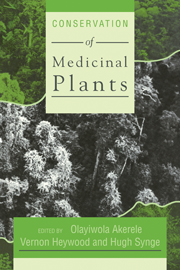Book contents
- Frontmatter
- Contents
- Contributors
- Preface
- Acknowledgements
- The Chiang Mai Declaration
- Introduction
- The Issue of Medicinal Plants
- Science, Industry and Medicinal Plants
- Techniques to Conserve Medicinal Plants
- 10 Agronomy Applied to Medicinal Plant Conservation
- 11 Biotechnology in the Production and Conservation of Medicinal Plants
- 12 Enhancing the Role of Protected Areas in Conserving Medicinal Plants
- 13 Botanic Gardens and the Conservation of Medicinal Plants
- 14 The Role of Chinese Botanical Gardens in Conservation of Medicinal Plants
- Policies to Conserve Medicinal Plants
- Experiences from Programmes to Conserve Medicinal Plants
11 - Biotechnology in the Production and Conservation of Medicinal Plants
Published online by Cambridge University Press: 07 September 2010
- Frontmatter
- Contents
- Contributors
- Preface
- Acknowledgements
- The Chiang Mai Declaration
- Introduction
- The Issue of Medicinal Plants
- Science, Industry and Medicinal Plants
- Techniques to Conserve Medicinal Plants
- 10 Agronomy Applied to Medicinal Plant Conservation
- 11 Biotechnology in the Production and Conservation of Medicinal Plants
- 12 Enhancing the Role of Protected Areas in Conserving Medicinal Plants
- 13 Botanic Gardens and the Conservation of Medicinal Plants
- 14 The Role of Chinese Botanical Gardens in Conservation of Medicinal Plants
- Policies to Conserve Medicinal Plants
- Experiences from Programmes to Conserve Medicinal Plants
Summary
Need for Medicinal Plants
Medicinal plants are the oldest source of pharmacologically active compounds. They remained to be the only source of useful medicinal compounds for centuries. It is estimated that even today 2/3 of the world population relies on plant-derived drugs. It was not until the last century that through increasing scientific knowledge in the western world new sources and methods for the production of medicinal compounds were found, such as synthetic substances, antibiotics produced by fungi or bacteria, hormones extracted from animal tissues, or vaccines produced by animals or animal cell culture systems.
Today in a typical industrialized nation like West Germany 72% of all chemically defined substances, contained in medicinal preparations available on the market, are produced by organic synthesis, 11% are obtained from microbes only 5% are produced with animals or animal cell cultures, while 12% are still plant-derived substances. Presently 75 different plant-derived secondary metabolites are in use and the medicines made from them represent a fraction of slightly more than 5% of the total. Substances most frequently used in medical preparations are cardiac glycosides, theophylline, vincamine, atropine, pilocarpine, codeine and scopolamine. Additionally a lot of important steroid compounds and hormones are derived semisynthetically from plant precursors.
Crude drugs are also still of considerable importance for medical treatment. Medicines made from crude drugs represent about 15% of the total on the German market. This might give an impression of commercial importance of plant-derived pharmaceuticals but to assess properly the medical importance of these drugs one has to focus on special indications. Crude drug preparations represent 25% of all available antihypertension and antitussive medicines.
- Type
- Chapter
- Information
- Conservation of Medicinal Plants , pp. 179 - 198Publisher: Cambridge University PressPrint publication year: 1991
- 1
- Cited by



